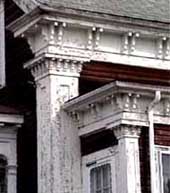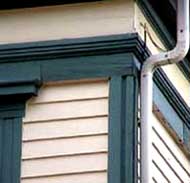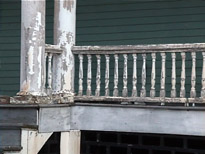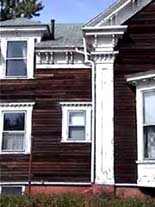What the "Skin" Does... Fits tightly over the frame
Fractured & fragmented? Smooth & burnished? Look at the condition of your skin. Is it fractured and fragmented, with cracks, open joints between parts, and a few pieces falling off here and there? If so, something is wrong!
The original builder made all those parts fit tightly together. Now, rub the surfaces with your open hand. Do they feel rough and jagged? Do loose paint chips scrape your skin? Do you get splinters and worry about cutting yourself on sharp glass or rusty nails? If so, something is wrong! The original builder left these surfaces smooth and burnished.
Defends against the weather
Shedding water or soaking it up? Look again. Tightly fitting parts and smooth burnished surfaces defend your historic house's exterior from the weather. Keeping wind, water and sun in check is critical because these are the agents of destruction. When the paint film cracks, moisture penetrates the wood, causing the paint to peel, and letting in more moisture. The added moisture then causes the wood to swell, opening up a joint where more water can enter. As a result, the skin of your historic house becomes loose and porous.
Finally, cracks, open joints, and peeling paint permit rain water to go inside, where the agents of destruction quietly continue their work. With smooth, burnished exterior skin, your house will be able to succesfully defend itself.
Responds to your ongoing care
Let it go, or take action? Just like a good friend, your historic house will respond to ongoing care. You know what happens when you ignore a friend, never call, and say "no" when asked to do a favor? So, do your house a favor and maintain it! Give that porch railing a fresh coat of paint. It will keep the wood beneath from rotting away. Your house will return the favor by costing you less to replace its precious parts over time, and, most important, will retain its historic character.
If you let that crack in the paint film go, the smooth surfaces will become rough; the tight joints will loosen and open up; the porch railing will rot; and you may end up falling off the porch and breaking a leg. Only one question remains: would you rather be lying in the snow and ice on a cold winter's night, or be out on your porch with a paint brush in your hand on a pleasant spring afternoon?
Keeps telling you not to wait...
Now or Never? Maintaining a historic house on a surface level--and on a planned, rotational basis--also means that you should be able to avoid wholesale "restoration campaigns."
If something has to be replaced, it generally means someone waited too long to repair it. And failure to repair one area, such as a simple downspout, affects larger areas, such as wood siding.
What you don't want is a disreputable, broken-down exterior as a result of neglect--or a brand new exterior as a result of having to replace almost everything! Graceful aging is what your house really wants from you in within a long-term relationship!




